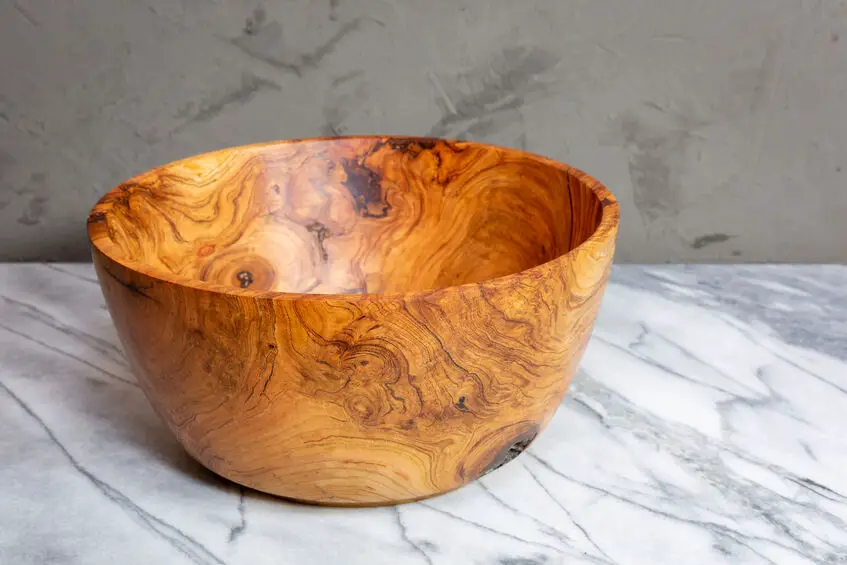Burled wood is often considered the oyster of the woodworking world and has a variety of uses. When it comes to woodworking projects, it’s essential to know when it comes in handy and how you can learn more about how it can be worked best.
What is Burled Wood and Where Can I Use it?
A burl is a large irregular growth found on trees and is caused by some sort of stress or injury. Most burled wood is safe to use when it was caused by an injury or insects. Some burls are caused by mold and should be used with caution. Grain direction is random in the burl itself.
If you’ve ever seen a tree that has an ugly growth that appears a bit unsettling with a tumor-like bulge, this is most certainly a burl. It’s comprised mainly of dormant buds that are all knotted together and if often caused by internal stress in a tree. This is when it’s been affected by some type of injury, fungus, and even viral fungi infestation. It’s not limited to insect activity that has infected parts of a tree as it grows.
There is no limit to where a burl can form and grow to immense sizes. Sometimes these are found at the roots of a tree, while others appear where branches would appear. As unpleasant as this affliction is for a tree, this isn’t posing any threat to the tree very much. It can inhibit the tree’s vascular system if burls become too large and begin choking out the watery fluids that keep a tree healthy.
Aside from this, woodworkers, artists, and wood sculptors find burled wood to be beautiful for a variety of projects. It can be used by slicing into thin veneer sections and used as inlay. It can be shaped into works of art and is favored by woodworking craftsmen while making cabinets and furniture. Because it’s so dense, it can be shaped into anything that is creative and attractive looking.
Where Burled Wood Comes From
Burled wood can come from many types of trees, but the ones in particular that appeal to woodworkers are from a selective group. The most popular come from Cherry, Oak, Ash, Maple, Elm, and Walnut. Then again it can also occur in Redwood, Spruce, Madrone, and Eucalyptus. The real attraction is how detailed the burl appears on the inside when it’s cut into sections.
Often it will come from a tree that has died or has fallen for whatever reason. If it comes from logging operations, these burls are sold to lumber suppliers who are interested in them. They’re not going to be used or processed into wood planks but instead, a burl on a tree trunk is separated from the rest of the healthy wood. Each burl section leaves a bit of wood on each side of the truck and then is sold to potential buyers.
Where can I get Burled Wood?
You can’t buy wood burls at your local lumber supplier unless they specialize in selling off wood burls. If you’re interested in getting a better deal, try to contact local companies or lumber mills. They will sell you an entire burl at a rock-bottom price without mark-up from a wood burl supplier. But in the case that you only need a small amount to work with, a single wood burl bought from a lumber mill will be more cost-effective.
After this, you only cut off what you need for each woodworking project. Outlets that sell burled wood have a mark-up of double or triple what you’ll pay from a lumber mill respectively. If you want a good deal, try using the Woodfinder search engine
what you’ll pay from a lumber mill respectively. If you want a good deal, try using the Woodfinder search engine which gives you instant access to lumber, veneer, and sawmill services across the US. You could take a chance using eBay to find smaller burl sections
which gives you instant access to lumber, veneer, and sawmill services across the US. You could take a chance using eBay to find smaller burl sections that might appeal to you.
that might appeal to you.
Does Burled Wood Come in Slabs?
Burl is also readily sold in slabs and sections that are used for fireplace mantels. The best advice for buying any kind of slab is to find the type of wood burl that appeals to you and make sure it’s in good condition. Slab thickness is going to determine the price that you pay, and depending on the amount of detail, will always influence the selling price. Once again, you can check eBay for sale prices to find better, more affordable deals.
to find better, more affordable deals.
Slabs are perfect for making into tables, shelves, mantelpieces, and tops of bedroom dresser drawers. Slabs are also ideal if you want to make smaller wood burl projects if the thickness of your slab is more than 2 or 3 inches. These can be sliced into thinner planks by using a reciprocating saw or a fine-toothed table saw. These slices can be used for all sorts of decorative inlays or woodworking projects.
Can I Turn Burled Wood on a Lathe?
You can turn burls on a lathe but there is a word of caution before you start. It’s better to turn wood burls that are still a bit green to prevent running into unexpected cracks. A fully dried burl sounds like a great option since it’s already shrunk, but this means it’s also very brittle. Turning anything on a lathe at high speeds is a risk if you don’t know what you’re doing. Here’s a sample tutorial from a 15-year old that made a simple bowl shape.
from a 15-year old that made a simple bowl shape.

For more advanced bowl shapes, this in-depth tutorial has more info on what to expect from turning burl wood.
has more info on what to expect from turning burl wood.
Is Burled Wood as Strong as Regular Wood?
Sadly, all wood burl isn’t as strong as regular wood planks. This is why you see thick planks used for tabletops or chair tops, so they can hold the weight of objects placed on top of it. In some cases, this is why burl veneer is used for thinner applications. It’s not really cheating as long as your veneer edge needs to match the top edges to hide a stronger wood slab inside used as a sandwich piece.
for thinner applications. It’s not really cheating as long as your veneer edge needs to match the top edges to hide a stronger wood slab inside used as a sandwich piece.
As a fun fact, wood burl, when it dries will dry evenly as opposed to regular wood since the formation of burl wood is very different than the layers of regular wood. You can see wood planks warping due to the wood grain, while burl is a series of buds and swirly shapes. As burl dries, the sheer number of inner burls will shrink uniformly

